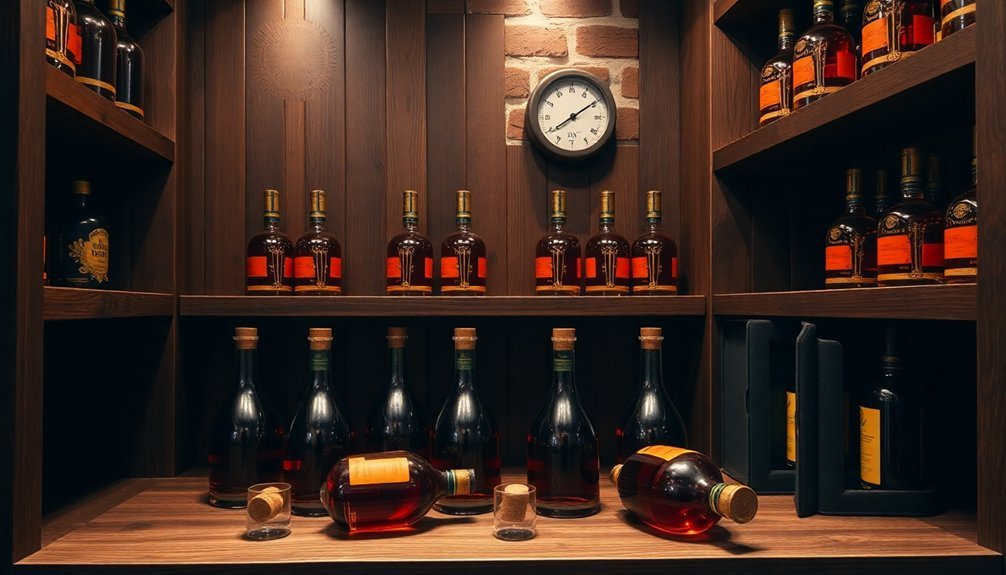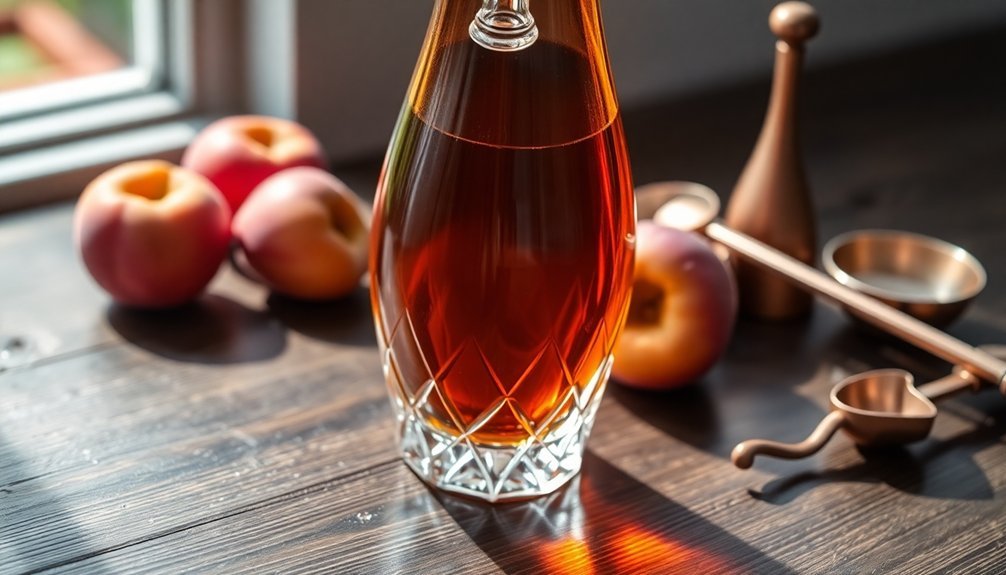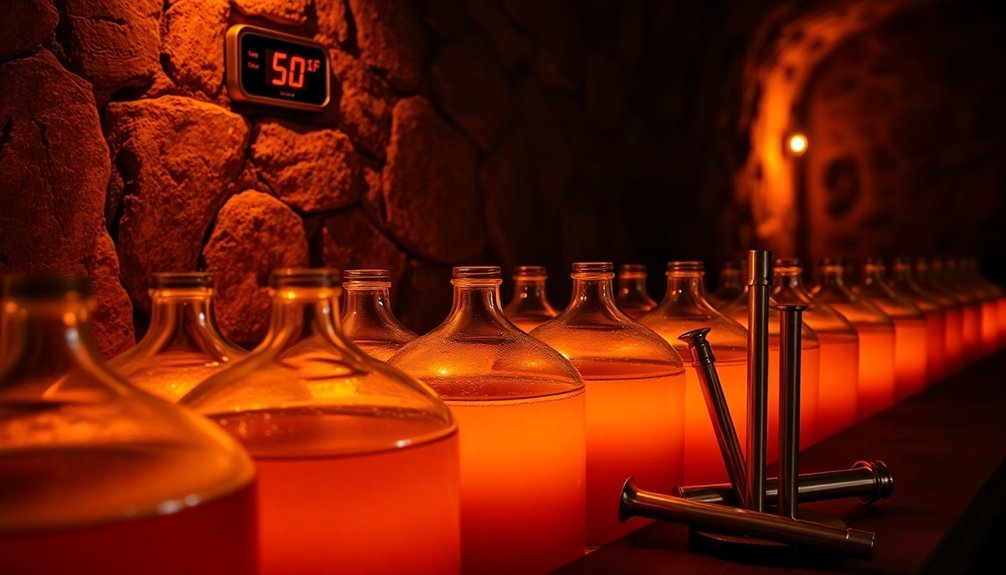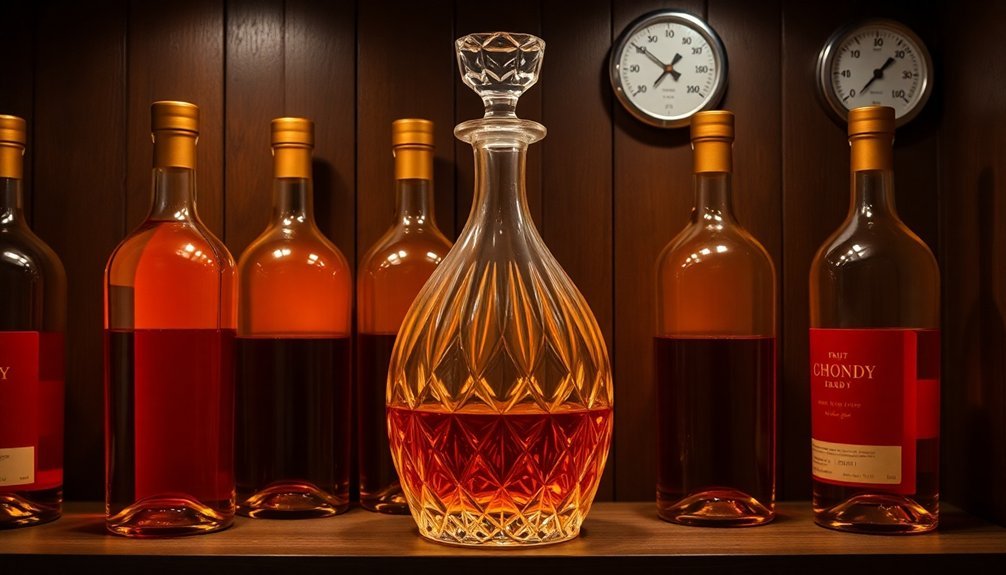To keep your fruit brandy fresh, you'll need to focus on five key storage principles. Store bottles upright in a cool, dark basement or cellar away from direct sunlight and heat sources to maintain consistent temperatures. Use high-quality borosilicate glass containers with airtight seals to prevent oxidation and unwanted flavor transfer. Balance your fruit-to-alcohol ratio carefully during production, and dilute to the proper ABV using clean spring water. Keep temperatures steady and avoid fluctuations from nearby appliances or vents. Monitor humidity levels between 55-70% using a humidistat. There's much more to mastering the art of brandy preservation than meets the eye.
Choose The Perfect Storage Location

The success of preserving your fruit brandy largely depends on finding the ideal storage spot. You'll want to focus on a location that maintains consistent, moderate temperatures while protecting your spirits from damaging light exposure. A basement or cellar often provides the perfect environment, as these spaces typically offer stable conditions year-round. Simple shelving units work best for storing bottles upright.
Choose a spot away from windows and direct sunlight to prevent color and flavor degradation. If you don't have naturally dark storage areas, consider using opaque or dark-colored containers to shield your brandy from harmful light.
You'll also need to guarantee your chosen location isn't prone to temperature fluctuations, which can compromise the brandy's quality. The storage area should maintain steady humidity levels – not too dry or too humid.
Position your bottles upright to protect the cork and prevent oxidation. If you can't store your brandy in a basement, select a cool, dark cabinet or closet that's away from heat sources and bright lighting. Avoid places like kitchen cabinets near your stove or shelves that receive afternoon sun.
Select Quality Glass Containers
Quality glass containers serve as your brandy's protective fortress, guaranteeing its character and complexity remain intact throughout storage. You'll want to invest in containers made from BPA-free borosilicate glass, which offers superior durability and thermal resistance. Square and round shapes are available to suit your specific storage preferences.
These containers feature non-porous surfaces that prevent unwanted flavor transfer and maintain your brandy's purity. Look for containers with airtight seals featuring BPA-free silicone rims. These seals are essential for controlling your brandy's maturation environment by minimizing air contact and preventing unwanted bacterial growth.
They'll also protect against leaks and spills, keeping your precious spirit secure. When selecting containers, prioritize versatility. Choose options that are dishwasher, freezer, and microwave safe for maximum convenience.
You'll appreciate how easy these containers are to clean, thanks to their smooth glass surfaces that resist staining and odor absorption. The clear glass allows you to monitor your brandy's condition easily, while the stackable design helps maximize storage space.
Remember to check that the containers are corrosion-resistant and won't leach chemicals into your brandy. This guarantees your spirit maintains its intended flavor profile throughout its storage period.
Master The Fruit-Alcohol Balance

Mastering fruit brandy's delicate balance requires precise control over your distillation cuts and alcohol content.
You'll need to discard the first 0.5-2% of your distillate to eliminate unwanted compounds, then begin collecting the hearts when your spirit reaches 70% ABV. Take small samples of 100-150ml to test quality and aroma retention throughout the process. Gradual heating of your pot still is essential for properly removing methyl alcohol.
To achieve ideal flavor, you'll want to dilute your spirit to the recommended ABV – typically 45% for most fruit brandies or 42% for geisted raspberry.
Don't rush the dilution process, as this can make your brandy cloudy. Use only the cleanest spring water or distilled water to maintain purity.
When blending your cuts, focus on preserving the signature fruit aroma while ensuring proper maturation.
You can choose to age your brandy in oak barrels for at least two years to develop complex flavors, or use glass balloons for up to ten years for a smoother taste.
Remember that consistent flavor comes from carefully blending brandies from different harvests and allowing adequate time for the flavors to properly fuse with the alcohol.
Maintain Proper Temperature Control
Having perfected your fruit-alcohol balance, proper temperature control becomes your next priority for preserving brandy quality.
You'll want to store your brandy in a consistently cool environment, as temperature fluctuations can greatly impact its integrity. Just like other spirits, fruit brandy requires stable temperatures during both storage and maturation to maintain its distinctive characteristics.
When you're selecting a storage location, focus on finding a spot that maintains a steady temperature year-round. Don't place your brandy near heating vents, kitchen appliances, or areas that experience regular temperature changes.
During maturation, controlled temperatures prevent excessive volatilization, which can affect the brandy's flavor profile and overall quality.
You'll also need to protect your brandy from direct sunlight, as UV rays can degrade both its color and taste. Choose a dark storage area to preserve the brandy's qualities, whether the bottle is opened or unopened.
If you've already opened a bottle, you should consume it within six months, as exposure to air can alter its characteristics. Always keep the bottle tightly sealed between uses to prevent unwanted evaporation and maintain the brandy's freshness.
Monitor Long-Term Storage Conditions

A well-monitored storage environment serves as your brandy's protective fortress against degradation.
You'll want to store your bottles in a cool, dark place away from direct sunlight, which can greatly alter the flavor and aroma of your spirit. Keep your storage area clean and free from strong-smelling foods to prevent unwanted flavor contamination.
Humidity control plays an essential role in preserving your brandy's quality. Maintain relative humidity levels between 55% and 70%, similar to wine storage conditions. You can use a humidistat to monitor these levels precisely, preventing issues like mold growth or dried-out corks.
Always store your brandy bottles upright to protect the cork from alcohol contamination, and make sure they're tightly sealed to prevent oxygen exposure.
If you've made fruit-infused brandy, you'll need to take extra precautions. After the initial 3-4 week steeping period, move the jar to your refrigerator to slow down fruit breakdown. Use the steeped fruit within three months, and consider straining it from the liquid if you're not planning immediate consumption.
Monitor the fruit's condition regularly to maintain best flavor and prevent spoilage.
Frequently Asked Questions
Can Fruit Brandy Be Stored in Plastic Containers for Short Periods?
While you can store fruit brandy in BPA-free plastic containers for short periods, it's not ideal since chemicals may leach into your drink. You'll want to transfer it to glass containers quickly.
How Do You Fix Overly Sweet or Bitter Fruit Brandy?
If your fruit brandy's too sweet, you can blend it with dry brandy or restart fermentation with alcohol-tolerant yeast. For bitterness, try adding sweeteners or aging it longer to mellow the flavors.
Is It Safe to Mix Different Fruits in One Batch?
Yes, you can safely mix different fruits in one batch. It's best to combine fruits with similar textures and sugar content. Make certain to monitor the mixture and shake regularly to guarantee even infusion.
Should Fruit Pieces Be Removed if They Float to the Top?
You shouldn't remove floating fruit pieces, but you'll need to keep them submerged in the alcohol. You can add more liquid or use a weight to prevent spoilage and guarantee proper preservation.
Can Homemade Fruit Brandy Be Safely Gifted to Others?
Yes, you can safely gift homemade fruit brandy if you've used sterilized bottles, properly steeped the mixture, and included storage instructions. Just label ingredients and preparation date for the recipient's reference.
In Summary
You'll find that preserving your fruit brandy's quality isn't complicated when you follow these essential storage practices. By selecting the right location, using proper glass containers, balancing your fruit-to-alcohol ratio, controlling temperature, and monitoring storage conditions, you'll maintain that perfect blend of flavors. Remember, you're protecting both the spirit's taste and your investment, so take time to implement these proven preservation methods.





Leave a Reply